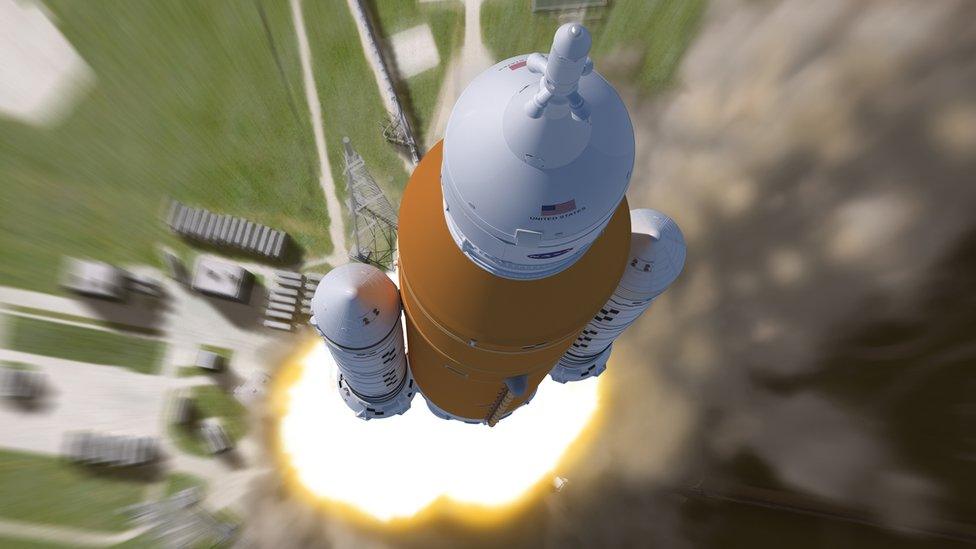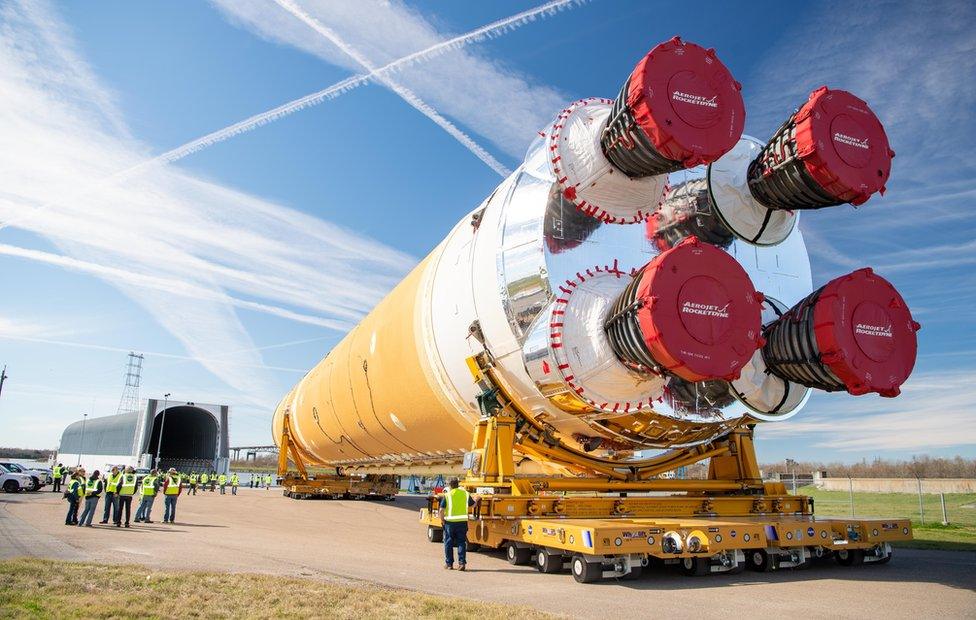Nasa's giant SLS rocket: A guide
- Published

Nasa has been developing a huge rocket called the Space Launch System (SLS) to launch astronauts to the Moon - and eventually Mars. Set to make its debut in early 2022, the SLS is the most powerful launch vehicle built since the 1960s.
Nasa has plans to send a man and woman to the lunar surface this decade, in what will be the first landing with humans since Apollo 17 in 1972.
In the last 20 years, astronauts have been making routine trips to and from the International Space Station (ISS).
But the Moon is nearly 1,000 times further than the ISS; getting astronauts there requires a monster rocket.
The SLS is the modern equivalent of the Saturn V, the huge launcher built during the Apollo era. Like the Saturn, it is split into segments, or stages, stacked on top of each other. But the rocket also incorporates technology from the space shuttle.
Allow YouTube content?
This article contains content provided by Google YouTube. We ask for your permission before anything is loaded, as they may be using cookies and other technologies. You may want to read Google’s cookie policy, external and privacy policy, external before accepting. To view this content choose ‘accept and continue’.
The first version of the SLS will be called Block 1. It will undergo a series of upgrades in coming years so that it can launch heavier payloads to destinations beyond low-Earth orbit.
The Block 1 SLS will tower 23 storeys above the launch pad - making it taller than the Statue of Liberty.
"It is truly an immense rocket. It is just jaw-droppingly big," said John Shannon, vice president and program manager for the SLS at Boeing, the rocket's prime contractor. He told BBC News in 2019: "When you see the SLS put together, you just haven't seen anything like it since the Saturn V."
The rocket will launch astronauts in Nasa's next-generation crew vehicle - Orion, boosting it to the speeds necessary to break out of low-Earth orbit and travel onwards to the Moon.

How the rocket works
The SLS consists of a giant core stage flanked by two solid rocket boosters (SRBs). The core houses two large storage tanks: one for liquid hydrogen, the fuel, and another for liquid oxygen, an "oxidiser", which makes the fuel burn.
Together, these are known as propellants.
At the base of the core stage are four RS-25 engines, the same ones that powered the spaceplane-like shuttle orbiter, retired in 2011.

Workers inside the huge SLS hydrogen tank use a technique called friction stir welding to plug holes
When liquid hydrogen and oxygen are fed into the engine chambers and ignited with a spark, the chemical reaction produces vast amounts of energy and steam.
The steam exits engine nozzles at speeds of 16,000 km/h (10,000 mph) to generate thrust - the force that propels a rocket through the air.
The SRBs give the rocket extra power to escape gravity's clutches. These twin boosters stand more than 17 storeys tall and burn six tonnes of solid propellant each second. They provide 75% of total thrust during the first two minutes of flight.
Engineers test one of the RS-25 engines used by the SLS
The most powerful rocket ever?
If we use thrust as a measure, the SLS will be the most powerful rocket ever when it flies to space in 2022. The Block 1 SLS will generate 8.8 million pounds (39.1 Meganewtons) of thrust at launch, 15% more than the Saturn V.
In the 1960s, the Soviet Union built a rocket called the N1, in a bid to reach the Moon. Its first stage could produce 10.2 million pounds (45.4 Meganewtons) of thrust. But all four test flights ended in failure.
A future version of the SLS - called Block 2 cargo - should approach the N1's thrust levels. But a vehicle called Starship, being developed by Elon Musk's company SpaceX, should exceed both - producing as much as 15 million pounds (66.7 Meganewtons) of thrust. Starship is currently under development, although there is no firm date for its first orbital flight.

The SLS in numbers

The rocket will stand 98m (322ft) tall in its initial, or Block 1, configuration
The Block 1 SLS can send more than 27 tonnes (59,500 pounds) to lunar orbits - the equivalent of 11 large sports utility vehicles (SUVs)
A future version of the SLS, called Block 2 Cargo, will launch 46 tonnes (101,400 pounds) to the Moon. That's 18 large SUVs.
The SLS will produce 8.8 million pounds (39.1 Meganewtons) of thrust in its Block 1 configuration
Four RS-25 engines sit at the base of the core stage; they're the same ones used in the space shuttle

How shuttle technology was re-used
The SLS core stage is based on the space shuttle's foam-covered external tank. This tank fed propellant to three RS-25 engines at the rear of the shuttle orbiter. The solid rocket boosters play much the same role in both vehicles.
But the SLS is a very different beast. A number of components and structures derived from the shuttle underwent significant design changes because of the different levels of stress placed on them by the SLS.
As an example of these different stresses, in the space shuttle, the RS-25 engines were canted up and away from the solid rocket boosters. Moving them next to the SRBs exposes them to more shaking. As a result, every system in the complex SLS engine section had to be rigorously tested to ensure it could withstand the vibrations.
Ignition: This solid rocket booster will be used for missions to the Moon
Why the SLS was built
In February 2010, the Obama administration cancelled Constellation, external - George W Bush's troubled plan to return to the Moon by 2020. The news came as a devastating blow to workers in five southern states - Alabama, Florida, Louisiana, Mississippi and Texas - where Nasa's human spaceflight programme funded tens of thousands of jobs., external
Some Capitol Hill legislators were furious. At the time, Richard Shelby, a republican senator from Alabama, said, external Congress would not "sit back and watch the reckless abandonment of sound principles, a proven track record, a steady path to success, and the destruction of our human spaceflight programme".
As a compromise, lawmakers from affected states insisted on a single super heavy-lift rocket to replace the Constellation launchers cancelled by the White House.

The first SLS core stage being transported from New Orleans to Mississippi for testing
The SLS design was unveiled in 2011, external. After work started, delays and cost overruns gave ammunition to critics, who thought Nasa should rely on rockets operated by commercial providers.
But without significant modifications, no existing boosters have sufficient power to send Orion, astronauts and large cargo to the Moon in one flight - as the SLS would have.
An estimated $18bn has been spent on the SLS since the beginning of the last decade.
But with the rocket's development phase over and its flight certification tests complete, the first SLS is now at Florida's Kennedy Space Center, being prepared for its maiden launch.
John Shannon, who has been in charge of the SLS at Boeing since 2015, explained: "I suspect that once SLS is in the national capability there won't be a need for another heavy-lift vehicle like it for many years. So this is really a once-in-a-generation opportunity."
Follow Paul on Twitter., external